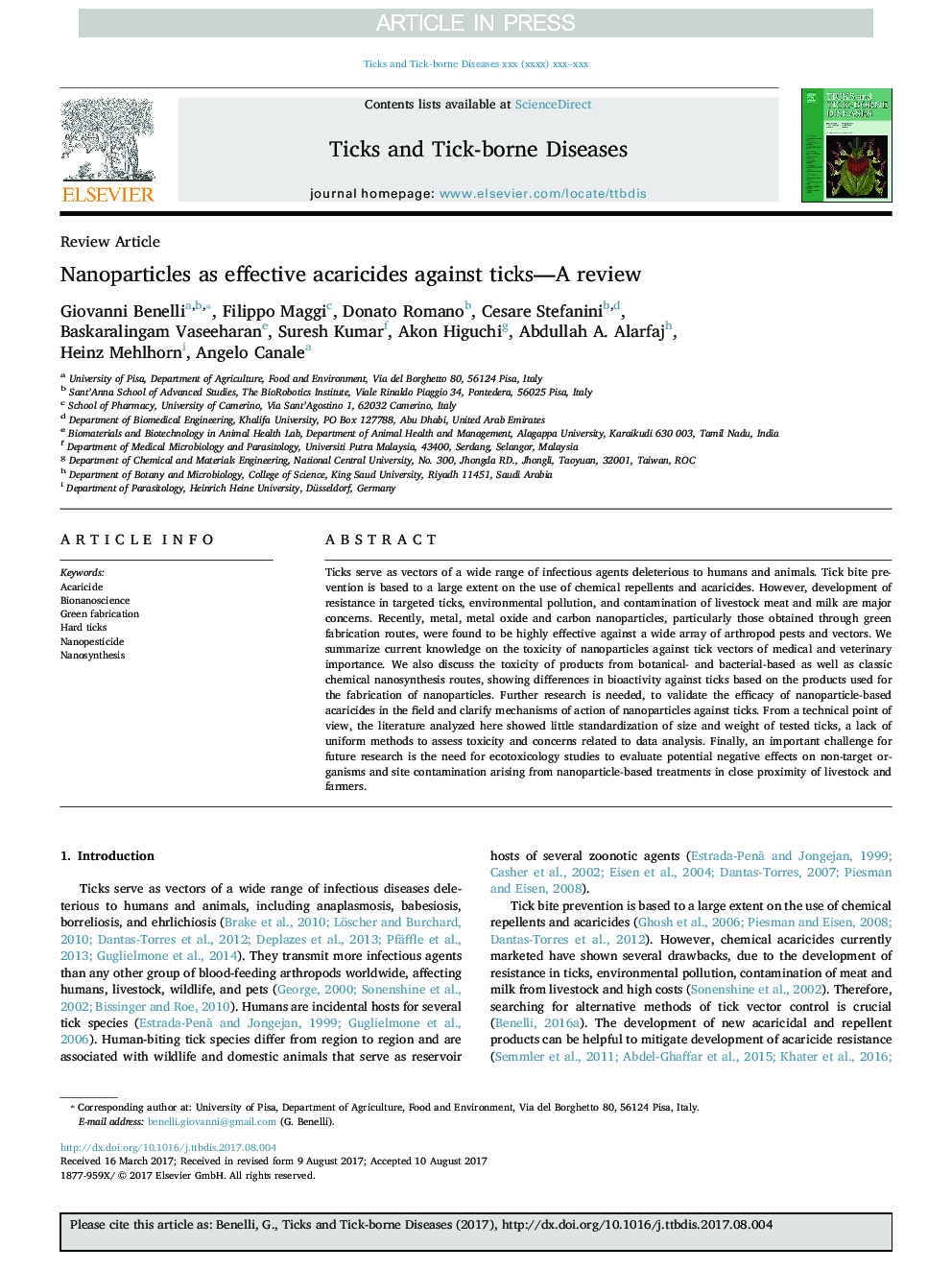| کد مقاله | کد نشریه | سال انتشار | مقاله انگلیسی | نسخه تمام متن |
|---|---|---|---|---|
| 5546265 | 1555964 | 2017 | 6 صفحه PDF | دانلود رایگان |
عنوان انگلیسی مقاله ISI
Nanoparticles as effective acaricides against ticks-A review
ترجمه فارسی عنوان
نانوذرات به عنوان آکواریس های مؤثر علیه کنه ها - بررسی
دانلود مقاله + سفارش ترجمه
دانلود مقاله ISI انگلیسی
رایگان برای ایرانیان
ترجمه چکیده
علف های هرز به عنوان بردارهای طیف وسیعی از عوامل عفونی در معرض خطر انقراض انسان و حیوانات هستند. پیشگیری از ضایعات تیکه به میزان زیادی در استفاده از مواد شیمیایی ضد انعقادی و آکریاریدها به کار رفته است. با این حال، توسعه مقاومت در کنه های هدفمند، آلودگی محیط زیست و آلودگی گوشت حیوانات و شیر، نگرانی های عمده ای است. به تازگی، فلزات، اکسید فلزی و نانوذرات کربنی، به خصوص آنهایی که از طریق راه های تولید سبز به دست آمده، در برابر بسیاری از آفات و بردارهای بوته ای بسیار موثر هستند. ما خلاصه دانش فعلی در مورد سمیت نانوذرات در برابر علامت های علامت اهمیت پزشکی و دامپزشکی. ما همچنین مسائل مربوط به سمیت محصولات نانوسنتز شیمیایی بر پایه گیاهان دارویی و باکتریایی و همچنین کلاسیک شیمیایی را مورد بحث قرار می دهیم که نشان دهنده تفاوت در عملکرد زیستی در برابر کنه ها بر اساس محصولات مورد استفاده برای ساخت نانوذرات است. تحقیقات بیشتری لازم است تا اثربخشی آکریاریدهای مبتنی بر نانوذرات در زمینه را روشن کند و مکانیسم های عمل نانوذرات را در برابر کنه ها روشن کند. از دیدگاه فنی، ادبیات مورد تجزیه و تحلیل در اینجا استانداردی از اندازه و وزن کنه های مورد آزمایش نشان داد، عدم وجود روش های یکنواخت برای ارزیابی سمیت و نگرانی های مربوط به تجزیه و تحلیل داده ها. در نهایت، یک چالش مهم برای تحقیقات آینده، نیاز به مطالعات اکولوژیک سم شناسی برای ارزیابی اثرات منفی بالقوه بر موجودات غیر هدفمند و آلودگی سایت ناشی از درمان نانوذرات در نزدیکی دام و کشاورزان است.
موضوعات مرتبط
علوم زیستی و بیوفناوری
علوم کشاورزی و بیولوژیک
علوم دامی و جانورشناسی
چکیده انگلیسی
Ticks serve as vectors of a wide range of infectious agents deleterious to humans and animals. Tick bite prevention is based to a large extent on the use of chemical repellents and acaricides. However, development of resistance in targeted ticks, environmental pollution, and contamination of livestock meat and milk are major concerns. Recently, metal, metal oxide and carbon nanoparticles, particularly those obtained through green fabrication routes, were found to be highly effective against a wide array of arthropod pests and vectors. We summarize current knowledge on the toxicity of nanoparticles against tick vectors of medical and veterinary importance. We also discuss the toxicity of products from botanical- and bacterial-based as well as classic chemical nanosynthesis routes, showing differences in bioactivity against ticks based on the products used for the fabrication of nanoparticles. Further research is needed, to validate the efficacy of nanoparticle-based acaricides in the field and clarify mechanisms of action of nanoparticles against ticks. From a technical point of view, the literature analyzed here showed little standardization of size and weight of tested ticks, a lack of uniform methods to assess toxicity and concerns related to data analysis. Finally, an important challenge for future research is the need for ecotoxicology studies to evaluate potential negative effects on non-target organisms and site contamination arising from nanoparticle-based treatments in close proximity of livestock and farmers.
ناشر
Database: Elsevier - ScienceDirect (ساینس دایرکت)
Journal: Ticks and Tick-borne Diseases - Volume 8, Issue 6, October 2017, Pages 821-826
Journal: Ticks and Tick-borne Diseases - Volume 8, Issue 6, October 2017, Pages 821-826
نویسندگان
Giovanni Benelli, Filippo Maggi, Donato Romano, Cesare Stefanini, Baskaralingam Vaseeharan, Suresh Kumar, Akon Higuchi, Abdullah A. Alarfaj, Heinz Mehlhorn, Angelo Canale,
